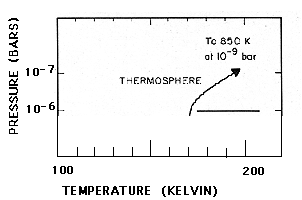This is a diagram showing the temperature profile.
Click on image for full size
Image from: Arizona Press
Uranus' Thermosphere Temperature Profile
This is the temperature profile of Uranus' thermosphere. The thermosphere is the other region of the atmosphere where warming takes place. On Uranus, incoming particles from the magnetosphere play a strong role in raising the temperature of this region. The thermosphere is also warmed from the sun's ultraviolet radiation. There is no top, or thermopause, to the thermosphere.
The graph shows that the temperature goes from about 170 kelvins (-153° F) to about 850 K (1,100° F).
For a picture showing how the temperature changes in whole atmosphere, click here.
You might also be interested in:
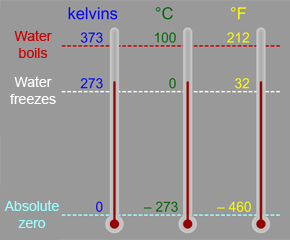
The Kelvin scale is a temperature scale that is often used in astronomy and space science. You are probably more familiar with the Celsius (or Centigrade) scale, which is part of the metric system of measures,
...more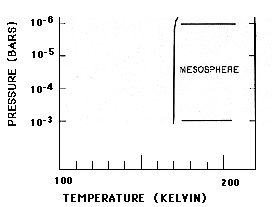
This is the temperature profile of Uranus' mesosphere. The temperature is the same at all heights until the mesopause, or "top" of the mesosphere is reached. As shown in the figure, the mesopause is placed
...more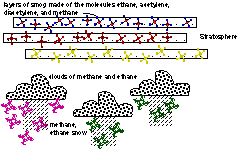
Besides methane, Uranus' atmosphere contains even more complex molecules such as ethane gas. (These gases are similar to the exhaust gases that come out of cars on earth). These molecules form layers of
...more
The mesosphere of Uranus is a region of balance between warming and cooling. That essentially means that nothing happens there. Except for diffusion, the atmosphere is still. Upper reaches of the atmosphere,
...more
As on Earth, the atmosphere of Uranus consists of a troposphere, stratosphere, mesosphere, and thermosphere. The troposphere is the region where the visible clouds are to be found. The stratosphere, as
...more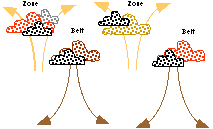
On Uranus, as on Jupiter, the winds in the belts and zones blow first in one direction, then in the opposite direction. Wind blows east in a belt, and west in a zone. The clouds rise up in a belt, and
...more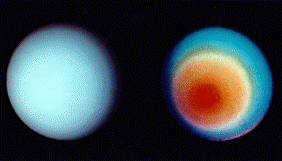
The clouds on Uranus, like Jupiter, are divided into belts and zones. On Uranus the belts and zones are hard to find. The left picture shows the north pole of Uranus. In this picture only the smog of
...more


